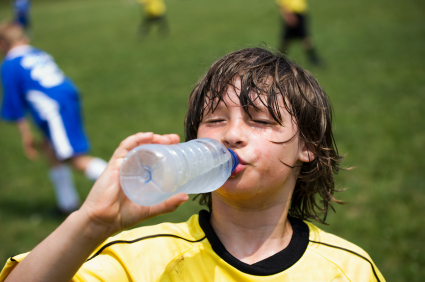There has long been a myth that children are more vulnerable to heat than adults. The myth was based on the first laboratory studies looking at youth exercising in the heat, conducted in the 1970's and 1980's, which reported that children had higher core temperatures, heart rates, and lower sweat rates. 
The problem was that many of the early studies compared children and adults completing treadmill exercise at the same absolute speed instead of having the two populations complete exercise at the same relative intensity.
Since then, new, more reliable studies have been conducted which have found the following:
1. Children have a greater skin surface area compared to their mass. This means they can effectively dissipate heat through non-evaporative means, particularly in mild to moderately hot environments
- This partially negates the fact that children have smaller sweat rates (evaporative heat dissipation)
- However, in very hot conditions it is important to keep in mind that non-evaporative heat dissipation declines
2. Youth have lower sweat rates than adults particularly among boys when compared to men (not as much of a difference between girls and women). This has been reported in numerous studies and is part of the reason the vulnerability myth was probably developed and perpetuated. Experts now agree that the lower perspiration rate among children should no longer be considered a disadvantage. Instead it simply reflects the fact that youth handle heat differently than adults:
- Youth depend on non-evaporative heat dissipation while advantageously conserving fluids (vital for bodily functions);
- Since adults sweat more, sweat drippage occurs more frequently. Sweat that drips from the body does not dissipate heat. Sweat drippage occurs less frequently in children. This leads to the notion that children are more efficient sweaters since the majority of their sweat evaporates.
- Additional research indicates that since the sweat glands of children are closer together, their sweat droplets more likely to evaporate, once again making them more efficient sweaters.
3. Cardiac output is similar to adults. When research has taken into account surface area, cardiac output is similar in children and adults. This means that youth are just as efficient as adults at pumping blood to their arms and legs for dissipation when their size is taken into consideration.
4. Youth have higher skin blood flow in mild to moderately hot conditions, which allows them to dissipate heat more efficiently through non-evaporative means.
- Note, however, that there is little research conducted on youth exercising at high intensity and in very hot environments, so little is known about potential changes in skin blood flow under these conditions.
5. Youth DO expend more energy while exercising then adults. Anecdotal evidence suggests that children are better at adjusting their intensity to make accommodations in the heat than adults (in other words, they listen to their bodies more and slow down)
6. Youth regulate core temperature just as effectively as adults. Contrary to earlier studies which found decreased heat tolerance, recent investigations taking into relative intensity report that children effectively regulate their core temperatures the same as the comparison adult group.
7. Youth make the same changes during heat acclimatization as adults, but more slowly. Heat acclimatization allows the human body to make adaptations to handle the heat better. Research reports that children make these adaptations and therefore can efficiently handle the heat. However, the same research indicates that these adaptations take longer to make, which means the majority of adaptations occur later during the process than adults.
Conclusion
Taken together, more recent research has effectively dispelled the myth that children are more vulnerable to the heat. While youth use a different thermoregulation strategy than adults. they are still efficient at dissipating and handling the heat in mild to moderately hot conditions.
In extremely hot conditions little research has been conducted, so the same conclusions can't yet be drawn. As a result, while exercising caution in warm to hot conditions is recommended for all athletes, it is particularly good advice for children exercising in very hot conditions.
Posted July 13, 2012








